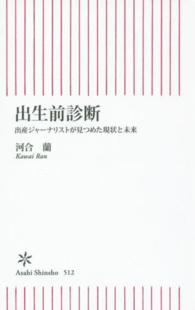Full Description
Better Hearing with Cochlear Implants provides a comprehensive account of a decades-long research effort to improve cochlear implants (CIs). The research was conducted primarily at the Research Triangle Institute (RTI) in North Carolina, USA, and the results provided key pillars in the foundation for the present-day devices. Although many of these results were reported in journal articles and other publications, many others were only reported in Quarterly and Final Progress Reports for the National Institutes of Health, which supported the RTI effort. In addition, the Progress Reports provided details that could not be included in the publications. The book is an annotated compilation of the most important sections from the most important reports that gives readers access to previously unpublished data and also a broad and logically organized overview of the research. Four main sections are included to describe the major lines of investigation: design and evaluation of novel processing strategies; electrical stimulation on both sides with CIs; combined electric and acoustic stimulation of the auditory system; and representations of temporal information with CIs.Large advances were made in each of these areas, and readers will appreciate the significance of the research and how the different areas related to each other.
Each main section includes an introduction by the authors followed by two or more chapters, and the first chapter in the book describes the work conducted at the RTI in the context of the multiple other efforts worldwide. The book may be used as a primary text on CIs, and it can serve as a multifaceted reference for physicians, audiologists, neuroscientists, designers of neural prostheses, and scientists and other specialists whose work is aimed at the remediation of hearing loss. In all, a fascinating history is presented, which began with little or no speech recognition with CIs for any user and ended with high levels of speech recognition for the great majority of users, including the ability to converse with ease via cell phones. This is a long trip in a short time, and historians of science and technological developments will be interested in knowing how such a rapid development was possible, and about the twists and turns on the way to the destination.
Contents
Acknowledgments Dedication Chapter 1 Overview PART I Design and Evaluation of Novel Processing Strategies Introduction Chapter 2 Comparison of Analog and Pulsatile Coding Strategies for Multichannel Cochlear Prostheses Chapter 3 New Levels of Speech Reception with Cochlear Implants Chapter 4 Evaluation of Alternative Implementations of the Continuous Interleaved Sampling (CIS), Interleaved Pulses (IP), and Peak Picker (PP) Processing Strategies Chapter 5 Comparison of Compressed Analog (CA) and Continuous Interleaved Sampling (CIS) Processors in Tests with Seven Ineraid Subjects Chapter 6 Evaluation of Other Promising Strategies Chapter 7 Completion of "Poor Performance" Series Chapter 8 Auditory Brainstem Implant (ABI) Studies Chapter 9 Virtual Channel Interleaved Sampling (VCIS) Processors: Initial Studies With Subject SR2 Chapter 10 Identification of Virtual Channels on the Basis of Pitch Chapter 11 Further Evaluation of VCIS Processors Chapter 12 Design for an Inexpensive but Nonetheless Highly Effective Cochlear Implant System Chapter 13 22-Electrode Percutaneous Study: Results for the First Five Subjects PART II Electrical Stimulation on Both Sides With Cochlear Implants Introduction Chapter 14 Speech Reception With Bilateral Cochlear Implants Chapter 15 Sensitivities to Interaural Timing Differences Chapter 16 Pitch Ranking of Electrodes for 22 Subjects With Bilateral Cochlear Implants PART III Combined Electric and Acoustic Stimulation (EAS) of the Auditory System Introduction Chapter 17 Psychophysical Studies Relating to Combined EAS Chapter 18 Speech Reception With Combined EAS PART IV Representations of Temporal Information With Cochlear Implants Introduction Chapter 19 Temporal Representations With Cochlear Implants Chapter 20 Strategies for the Repair of Deficits in Temporal Representations With Cochlear Implants Chapter 21 High Rate Studies, Subject SR2 Appendix A. Partners in Research Appendix B. Topics and Authors for the RTI Progress Reports Appendix C. Publications Resulting from the RTI Projects Appendix D. Contents of the RTI Progress Reports Sorted by Topic References Index








